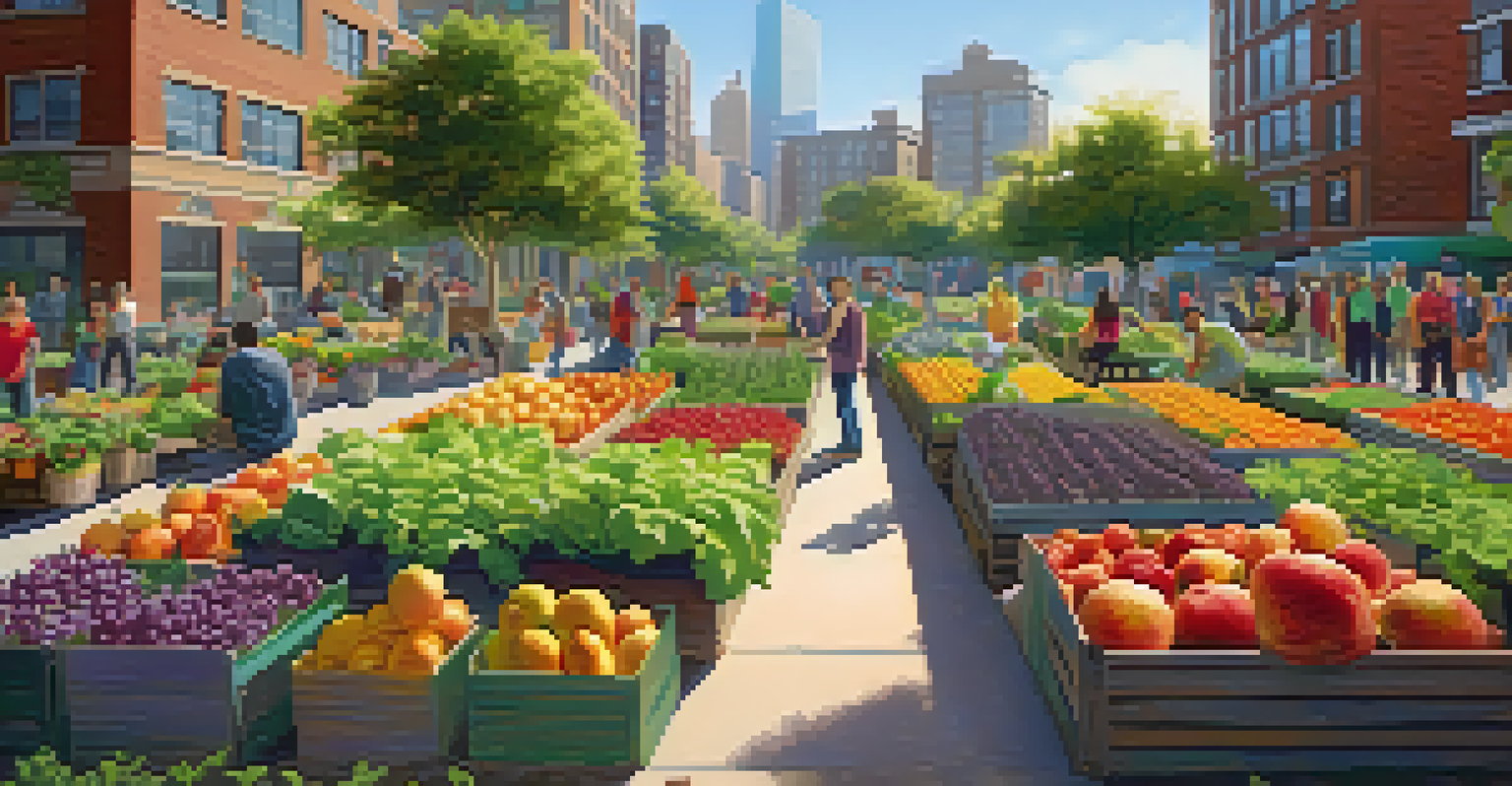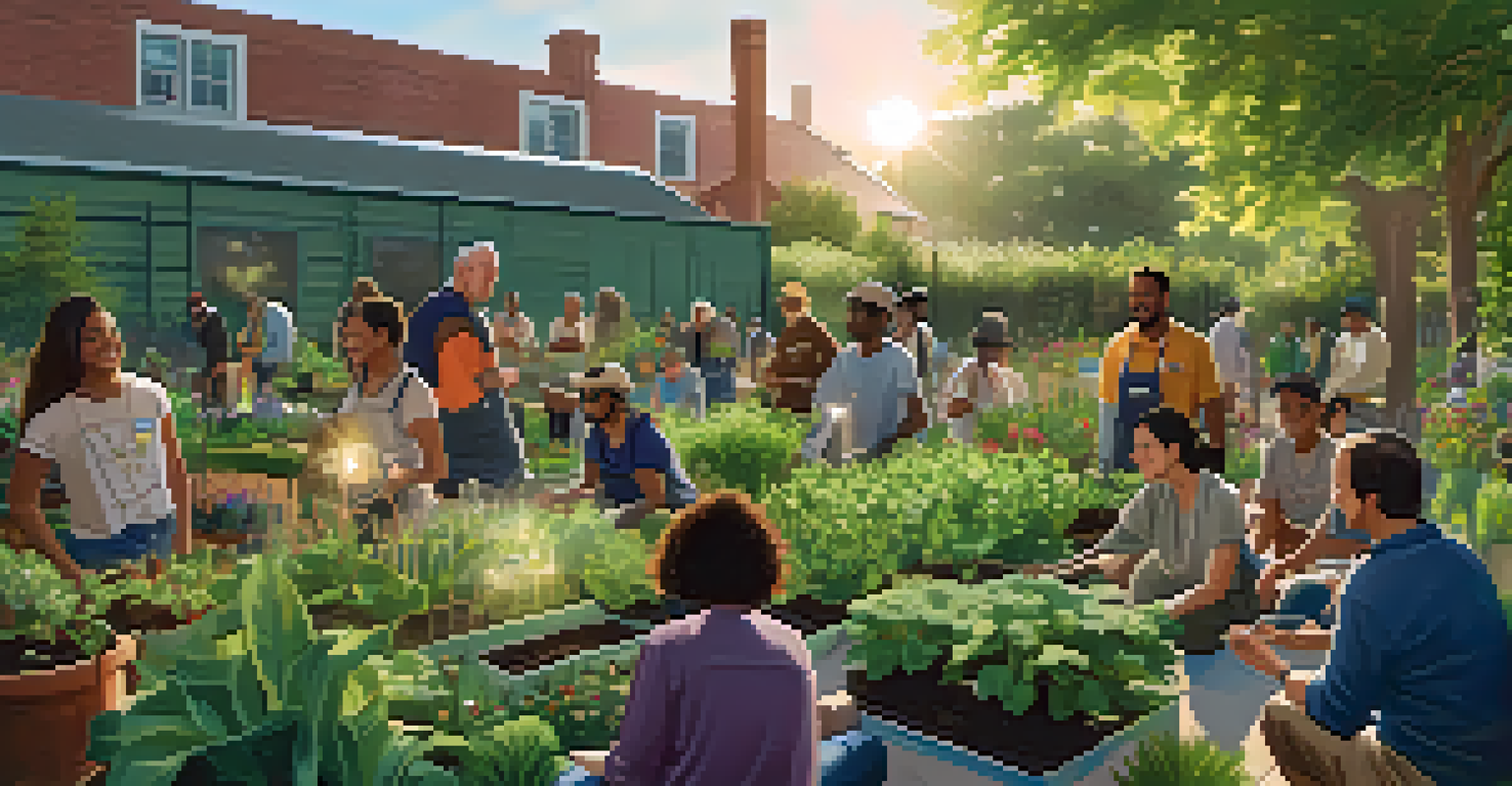The Role of Community Gardens in Promoting Urban Agriculture

Understanding Community Gardens and Their Purpose
Community gardens are shared plots of land where individuals come together to grow fruits, vegetables, and flowers. These gardens serve not only as a source of fresh produce but also as a space for community interaction and learning. They encourage local residents to engage in sustainable practices while fostering a sense of belonging and ownership.
Gardening adds years to your life and life to your years.
The primary goal of community gardens is to provide access to green spaces in urban areas, which can often be lacking. By transforming vacant lots or neglected public spaces into vibrant gardens, communities can improve their overall environment. This transformation is vital, as it promotes biodiversity and attracts various pollinators, ultimately benefiting the ecosystem.
Moreover, community gardens often prioritize education, offering workshops and resources on gardening techniques, nutrition, and sustainable practices. This educational aspect empowers individuals to take charge of their own food production, creating a ripple effect that can inspire broader changes in urban agriculture.
Benefits of Community Gardens for Urban Residents
Community gardens provide numerous benefits for urban residents, including access to fresh, organic produce. In many cities, food deserts—areas with limited access to affordable and nutritious food—pose significant health risks. By cultivating fruits and vegetables locally, these gardens help bridge the gap and promote healthier eating habits.

In addition to food access, community gardens contribute to mental and physical well-being. Gardening is a therapeutic activity that can reduce stress and foster a sense of accomplishment. The act of nurturing plants encourages physical activity, which is essential in combating sedentary lifestyles common in urban settings.
Community Gardens Enhance Well-Being
They provide access to fresh produce, promote mental health, and foster social connections among urban residents.
Furthermore, community gardens create opportunities for social interaction among diverse groups. Neighbors come together to share gardening tips, recipes, and even cultural traditions related to food. This social aspect fosters a sense of community, breaking down barriers and building friendships among people from different backgrounds.
Economic Impact of Community Gardens
Community gardens can have a positive economic impact on urban areas by reducing food costs for families. When residents grow their own food, they save money on groceries, allowing them to allocate their finances to other essential needs. This self-sufficiency can be particularly beneficial in lower-income neighborhoods.
The future will be green, or not at all.
Additionally, community gardens can stimulate local economies by creating jobs related to gardening and agricultural education. From garden coordinators to workshop facilitators, these roles provide employment opportunities that contribute to the local economy. Moreover, surplus produce can be sold at farmers' markets, generating income for the garden and its participants.
By encouraging local food production, community gardens can also support small businesses. Local restaurants and markets may partner with these gardens to source fresh ingredients, fostering a sustainable food system that benefits everyone involved. This interconnectedness helps strengthen the community's economic resilience.
Environmental Benefits of Urban Gardening
Community gardens play a vital role in promoting environmental sustainability in urban areas. By converting paved surfaces or neglected land into green spaces, they help mitigate the urban heat island effect, which causes cities to become significantly warmer than surrounding areas. This cooling effect can improve the quality of life for residents.
Moreover, these gardens contribute to improved air quality by absorbing carbon dioxide and releasing oxygen. Plants also filter pollutants from the air, creating a healthier environment for everyone. With the ongoing challenges of climate change, community gardens serve as a crucial tool in promoting urban resilience.
Economic Benefits of Local Gardening
Community gardens reduce food costs for families and create job opportunities, boosting local economies.
Additionally, community gardens encourage biodiversity by providing habitats for various species, including bees and butterflies. This biodiversity is essential for maintaining healthy ecosystems, and it can also enhance crop yields through natural pollination. By fostering a vibrant environment, community gardens become essential allies in the fight for sustainability.
Challenges Faced by Community Gardens
While community gardens offer numerous advantages, they also face several challenges that can hinder their success. One significant issue is securing land access, as urban areas are often densely populated and land is at a premium. Navigating zoning laws and bureaucratic hurdles can be daunting for aspiring gardeners.
Funding is another critical challenge for community gardens. Many rely on grants, donations, or volunteer labor to maintain operations, which can be inconsistent. Without stable financial support, gardens may struggle to thrive, making it difficult to continue providing benefits to the community.
Additionally, community gardens require ongoing engagement from participants to ensure their sustainability. If involvement wanes, the garden may suffer from neglect or mismanagement. Building a committed community and fostering a sense of ownership is essential to overcoming these challenges and ensuring long-term success.
The Role of Education in Community Gardens
Education is a cornerstone of many community gardens, as it empowers individuals with the knowledge needed to cultivate their own food. Workshops and hands-on activities teach essential gardening skills, from planting to pest management. This knowledge equips participants to make informed decisions about their own gardens and food sources.
Moreover, community gardens often serve as platforms for broader discussions about food systems and sustainability. By engaging residents in conversations about where their food comes from, gardens can inspire critical thinking about agricultural practices and environmental impact. This awareness can lead to more sustainable choices in everyday life.
Sustainability Through Urban Gardening
These gardens improve air quality, support biodiversity, and help mitigate the urban heat island effect.
Additionally, community gardens can partner with local schools to offer educational programs for children. Teaching kids about gardening not only fosters an appreciation for nature but also encourages healthy eating habits from a young age. These educational initiatives create a lasting impact on future generations, instilling values of sustainability and community.
Future of Community Gardens in Urban Agriculture
The future of community gardens looks promising as urban agriculture continues to gain traction. With increasing awareness of food security and sustainability, more communities are advocating for green spaces in their neighborhoods. This growing interest can lead to the establishment of new gardens and the revitalization of existing ones.
Moreover, technology is playing a role in the evolution of community gardening. Innovations such as vertical gardens and hydroponics are making it easier to grow food in limited spaces. These advancements can help urban gardeners maximize their yield and ensure year-round production, making community gardens even more viable.

As cities prioritize green initiatives, community gardens may receive more support from local governments and organizations. Policies that promote urban agriculture can help secure funding and resources, ensuring that these gardens remain an essential part of the urban landscape. With continued community engagement and investment, the impact of community gardens on urban agriculture will only grow.